A CULINARY TOURIST IN
SAN MIGUEL DE ALLENDE, MEXICO
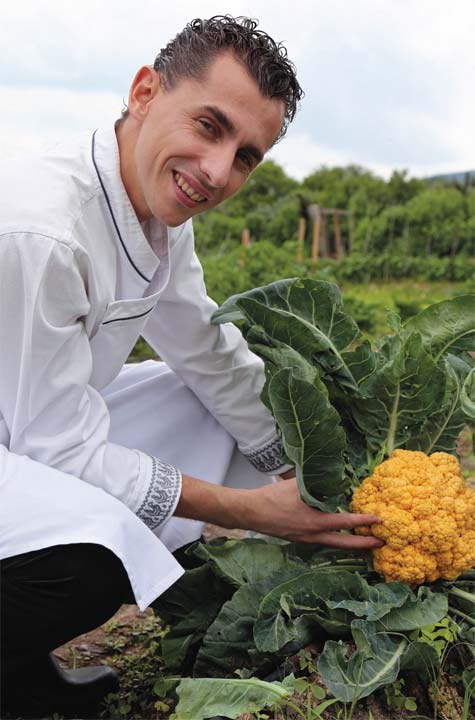 Chef Rurik Salazar selects vegetables for the 1826 Restaurant.
Chef Rurik Salazar selects vegetables for the 1826 Restaurant.
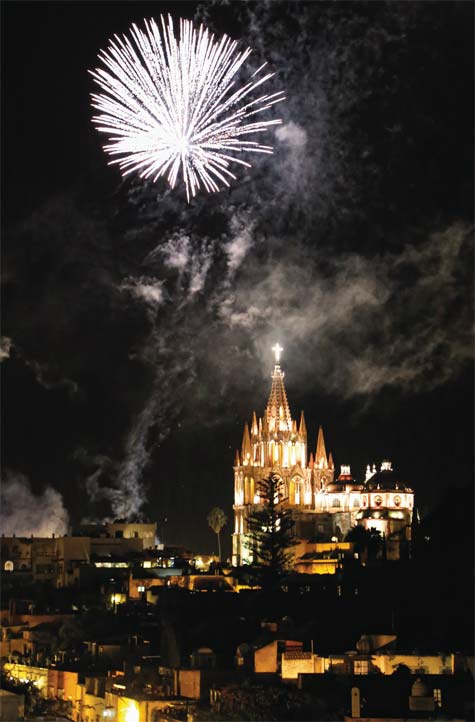 Fireworks over San Miguel from the Rosewood Hotel
Fireworks over San Miguel from the Rosewood Hotel
Photography by Terri Taylor
Though it’s rainy season in central Mexico, the overcast skies are clearing as our car rumbles toward the village of Jalpa, 15 miles from the colonial town of San Miguel de Allende. Many years ago, I became enchanted with San Miguel, an artsy oasis in the central Mexican highlands, and after a long absence, I’m eager to rediscover it and meet some of its local food producers.
Life still feels reassuringly simple here. Driving past rows of corn, I see families herding goats, and others tilling fields with horsedrawn plows. Today’s visit to the countryside has been arranged by the Rosewood Hotel San Miguel de Allende (rosewoodhotels.com). sister to Dallas’s Mansion on Turtle Creek. My tour guide is their stately young executive sous chef Rurik Salazar, one of Mexico’s rising culinary stars.
After several twists and turns down Jalpa’s rustic streets, our driver Sergio pulls up to a vine-draped façade. Massive wooden doors swing open, and a gatekeeper motions us onto the grounds of Purisima de Jalpa (purisimadejalpa.com), an 18th century hacienda that has been transformed into a thriving organic farm. The property, which includes the adjacent hillsides, wraps like a horseshoe around a large natural reservoir. Surrounding the grand main house are open fields and covered rows of assorted crops highly prized by the region’s top eateries, including the Rosewood’s fashionable 1826 Restaurant. Before I leave San Miguel, Chef Salazar will create an extraordinary six-course meal for me, utilizing Purisima’s produce. From the terrace, a platinum-haired woman comes forward to greet our car. In what can only be described as a San Miguel moment (mystical occurrences are common here), I feel certain that I know her. When Susan Zermeño Williams begins to speak—her throaty voice is warm and distinctive—it takes only a moment to link her to a memory. She was the first person to greet me on my initial visit to San Miguel 11 years ago. Once the manager of a popular B&B, Susan has now put her agronomy degree to work and is running the day-to-day operations of this 165-acre farm, which includes six guest suites.
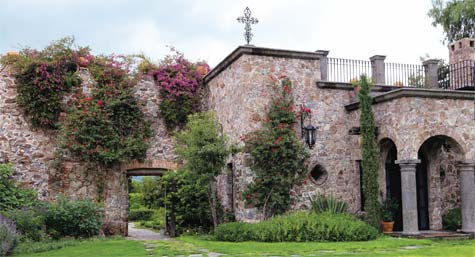 Purisima de Jalpa is an 18th century hacienda
Purisima de Jalpa is an 18th century hacienda
with an organic farm and luxury guest suites
We catch up over glasses of agua fresca made with the sweet purple fruit of the nearby garrambullo, a tree-like cactus. Soon we are joined by the farm’s American owner Janet Onnen, the person responsible for breathing new life into this village. She tells stories about the hacienda’s illustrious (and sometimes infamous) 250-year history as we gather cauliflower, baby corn, carrots, onions, Swiss chard and squash for Chef Salazar’s basket. The Bajio region is known for its agriculture, and these fertile valleys are enriched with ash from long dormant volcanoes.
In a covered structure not far from the fields, a woman is washing just-picked produce. In another outbuilding, two women are stripping rosemary from dried branches. Nailed across the wall, giant slings hold saved seeds. Several varieties of native beans lay drying on the floor. After our tour, we return to the patio for more agua fresca before we gather the chef’s bounty, say our goodbyes and head off to our next destination.
Down a pocked back road closer to town, we make our way to Vinícola Toyan (vinicolatoyan.com), the area’s first organic winery. Towering plane trees on either side of the drive remind me of France. But this is Mexico, with its penchant for ancient symbols. A strange assortment of sculpted faces are molded to the trees, the artistic handiwork of the vineyard’s proprietress Martha Molina, who, with her assistant Laura Chávez, welcomes us as we pull into the circular drive. Laura explains the faces: “Martha wanted to reflect the personality of each tree.” Some seem serious, some appear happy, all evoke an emotion.
The Molina family began growing organic vegetables here sixteen years ago with the idea of reviving the traditional ways of farming. Like their ancient predecessors, they use the cycles of the moon to guide their planting. They began their organic vineyard in 2007.
“In Mexico, the market for organic products is just beginning,” says Laura.
Chef Salazar and Martha walk between the vines, tasting grapes and discussing how many weeks until the vendimia (harvest). Chef brings me a few chardonnay grapes. There are other rows with cabernet sauvignon, merlot and sauvignon blanc. The vines are pruned high to make it comfortable for the women who pick the clusters. Down a steep dark incline guarded by blue-lit statues of monks, we venture into the vineyard’s cool underground cave and taste a buttery crisp chardonnay along with samples of Martha’s homemade panela cheese. I’m very impressed and so are the Rosewood chefs. Next month, Vinícola Toyan will be featured on their wine list.
Back in town, it’s nearing sunset as all of San Miguel scurries for a westerly-facing rooftop table with a view. On the Rosewood’s fourthfloor terrace, the Luna Bar, with its stunning panoramic vistas under the stars, is hard to beat. The bells chime from the neo-Gothic pink spires of La Parroquia, the diocese’s central church, as I share artisnal cocktails with cookbook author and culinary instructor Kris Rudolph (mexicocooks.com). A native of Houston, Kris has been in San Miguel, operating her catering business and restaurant El Buen Café, since 1991.
She also leads culinary tours to Italy, Slovenia and South Africa and is well aware of how travel expands one’s notions about food. “In Europe, like Mexico, people are still very seasonal in the way they eat,” she says. “The recipe may be simple, but it becomes a game to find the highest quality of ingredients.”
Several nights a week, she turns over El Buen Café’s kitchen to a young American chef Eric Draper for his farm-to-table dinners. She admits to being a little bemused by the concept. “The idea of farm-to-table isn’t a novel idea here. It’s the way people live. Queso de cabra?” She smiles. “Goat cheese has always been a Mexican staple. Now it’s being repackaged to look fancy.” Her employees raise goats and chickens and grow beans, corn and usually tomatoes around their homes. “Mexico has some of the most fertile soil in the world,” she tells me. “This is one of the country’s saving graces.”
Mexico is one of only a handful of countries to be recognized for the merits of its traditional cuisine by UNESCO, the United Nations’ agency devoted to cultural preservation. Food here is intricately tied to ancient sustainable farming methods, ancestral culinary techniques and age-old ceremonial customs.
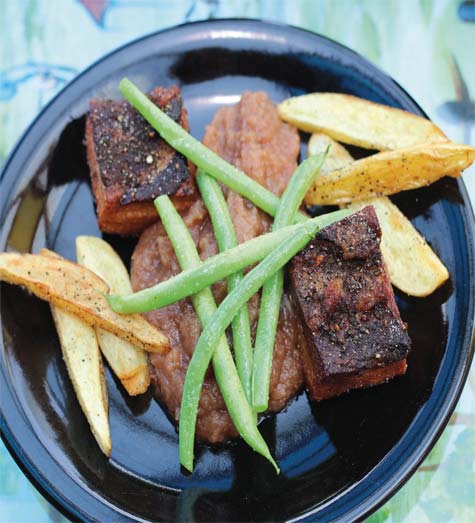 Pork Belly at De Temporada
Pork Belly at De Temporada
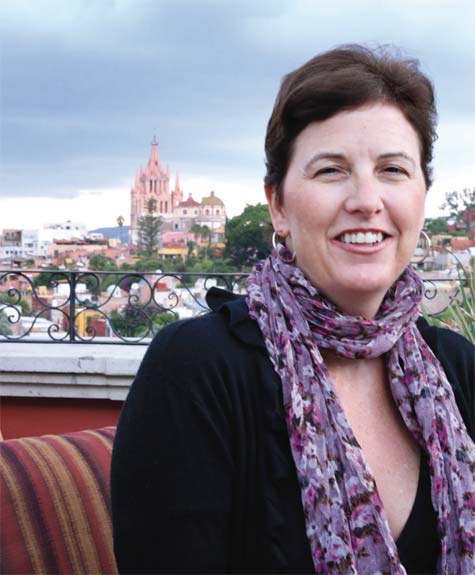 Kris Rudolph, owner of El Buen Café
Kris Rudolph, owner of El Buen Café
On Sunday, Kris’ day off, we share an organic brunch at Posada Corazon (posadacorazon.mx), a tranquil B&B hidden behind a sunset pink wall in the heart of town. We load our plates with homemade breads, jams, local cheeses and their signature egg dish— a fried egg (from their backyard chickens) wrapped in fragrant hoja santa leaves (fresh from their garden).
After eating, we walk through the garden and marvel at the variety just a few steps from the kitchen. “Hundreds of years ago,” Kris says, “the diezmo—the 10% tithe to the church—was collected here. This is where people brought their vegetables, beans, livestock or silver— to support the clergy.” This is the site of some of San Miguel’s oldest fruit and vegetable plots.
“I’m concerned about the potential reach of Monsanto in Mexico,” Kris says, speaking of the possibility that the corporation’s genetically modified corn could diminish local varieties. “This is the birthplace of corn, and you shouldn’t mess with that. The heirloom varieties are a sacred part of Mexican traditions.”
Kris echoes the sentiments of fellow culinary expert Diana Kennedy, a British expat who has devoted her life to recording Mexico’s regional cuisines. When Kennedy lectured earlier in the year at the Dallas Museum of Art, I was struck by her remark that a person from a specific village can tell if the corn tortilla he’s eating is made from local corn. This comment speaks to the distinctively different taste profiles that exist from region to region: a mind-blowing prospect to someone whose tortilla choice has been reduced to the generic question—flour or corn?
The following day, Kris takes me to De Temporada (de-temporada. com), a hip little open-air eatery perched at the edge of an organic field just outside of town. The owners, San Miguel-born Iliana Lanuza and New York-born James Walls constructed the restaurant in only a few months from a charming mish-mash of recycled materials. From our picnic table, we enjoy crisp pork belly with homemade applesauce while gazing out at the fields of Rancho la Trinidad, owned by Iliana’s family. Iliana, who studied sociology and received her master’s degree in food politics in London, speaks passionately about food and why opening this seasonal restaurant on family land is a dream fulfilled. “How we share food says a lot about us as a culture,” she says. “We’ve become so absent from our tables.”
Glancing across the fields, I consider Iliana’s words. This land where she was raised looks similar to small farms in North Texas. And her passion about a healthy and just food system is a sentiment expressed by like-minded people around the world.
At a nearby table, plates of food are being served as we say our goodbyes to Iliana. In Mexico, it’s a gesture of courtesy to recognize fellow diners as you pass their table. “¡Buen provecho!” we say, as we exit. “Enjoy your meal!” With this savvy farmer’s daughter manning the kitchen, how could they not?
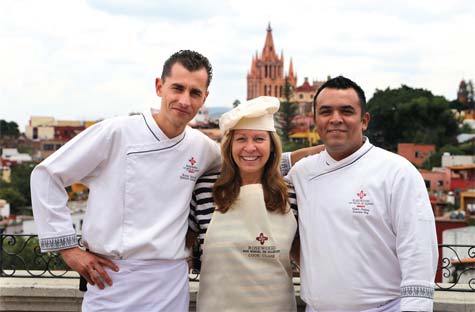 Writer with chefs Rurik Salazar and Victor Palma
Writer with chefs Rurik Salazar and Victor Palma
Photo by Gustavo Vidargas
COOKING AT THE ROSEWOOD
On the Rosewood Hotel’s rooftop terrace, our cooking class begins with a clink of tequila-filled glasses followed by sangrita, an orangey tomato juice chaser. The Rosewood’s charming, unflappable culinary team, led by executive chef Victor Palma and sous chef Rurik Salazar, will guide me, step-by-step, through the making of Chiles En Nogada, a dish I’ve been in love with since taking my first bite a decade ago.
This seasonal variation of chile relleno is traditionally made during the weeks leading up to September 16, Mexican Independence Day. Legend has it that the dish was first served on August 28, 1821 at the Convent of Santa Monica in the city of Puebla. The victorious Mexican general Agustín de Iturbide (who later became Mexico’s emperor) stopped there on his return to Mexico City from Veracruz, where he’d signed the treaty granting Mexico its independence. The patriotic Pueblan nuns created the recipe to commemorate the colors (red, green and white) of the newly designed Mexican flag.
Using seasonal fall ingredients, poblano peppers are stuffed with a picadillo (filling) of nuts, fruits and meats and then covered in a creamy walnut sauce (white) with speckles of sweet pomegranate seeds (red) and flecks of parsley (green). Many versions have sprung from the original, and the question of whether to batter and fry is debatable. In Puebla, the walnut is in season during the autumn. The Texas pecan is an easy substitute. “The recipe is flexible,” says Chef Palma. Use beef instead of pork. Choose fruits that are in season. What’s most crucial is to find the balance between savory and sweet.
Across a long table, Chef Palma has arranged an orderly presentation of ingredients; some gathered from Rosewood’s on-site garden. The onions and garlic sizzle and begin to caramelize. The tomatoes are added for color and acidity to balance out the sweet fruits. The spiced meat is added and the aromas are tantalizing. As the mixture simmers, I hear the whir of the blender, pureeing the goat cheese and walnuts.
The chef deftly fills the hollowed poblanos, drizzles them in a pool of nutty-flavored cream and finishes with the crowning adornments of ruby and green. With a plate before me, I chomp down on the first bite and ecstatically proclaim: “This is the very best I’ve ever tasted!” My compliment provokes a light-hearted discussion between the chefs who are also taking bites. Salazar, a native of Puebla, sheepishly admits that, although this is wonderful, his mother-in-law’s is absolutely the very best. Chef Palma nods his head in agreement and gives me a dimpled smile. “No one makes it better than Mom.”
RECIPE
As a kid, TERRI TAYLOR refused to eat her vegetables. Her veggie-phobia was cured in 1977 when she spent eight months working on farms in Norway and France. She studied journalism at UT-Austin and received a master’s degree in liberal arts from SMU. Her short story “Virginia” can be found in Solamente en San Miguel, an anthology celebrating the magical Mexican town of San Miguel de Allende. She has written for Edible DFW since its inaugural issue in 2009. She became the magazine’s editor in 2010 and is the editor of Edible Dallas & Fort Worth: The Cookbook.
-
Terri Taylorhttps://www.edibledfw.com/author/ttaylor/
-
Terri Taylorhttps://www.edibledfw.com/author/ttaylor/
-
Terri Taylorhttps://www.edibledfw.com/author/ttaylor/
-
Terri Taylorhttps://www.edibledfw.com/author/ttaylor/











